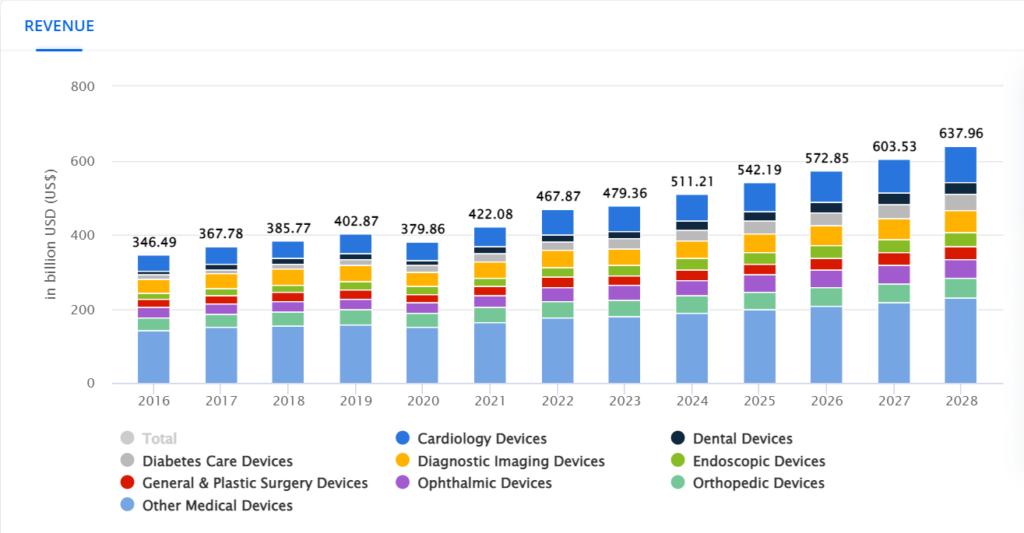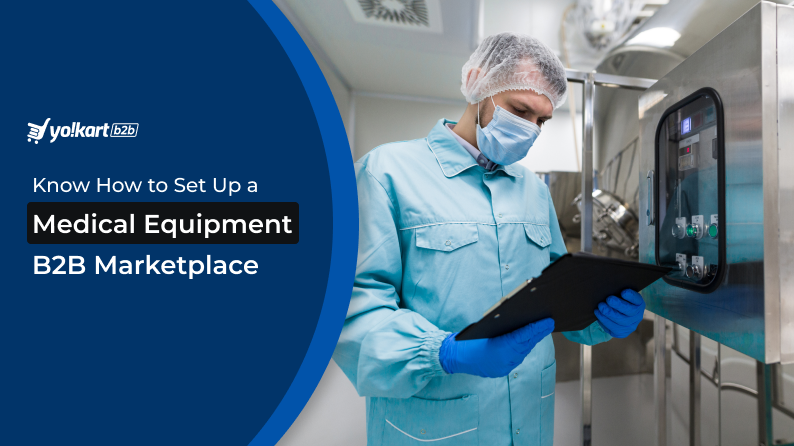Back in 2020, when the world grappled with the COVID crisis, one of the many impediments stalling healthcare’s response to the pandemic was a shortage of medical equipment, supplies, and other key paraphernalia. Scenes from those desperate times are still fresh in our memories. If that wasn’t enough, the Russo-Ukrainian also impacted the supply chains of some of the products. Here, a pivotal reassessment by the stakeholders and policymakers alike included making the supply chains more fluid and breaking through rigid shackles disrupting flexibility. An expected solution was digitalization ― with the need for versatility and greater transparency spurring the rise of medical equipment eCommerce marketplaces.
Fast forward to current times, the market for medical equipment is expected to rise from a projected US$511.20bn in 2024 to US$638.00bn by 2028, as estimated by Statista. It is a market that includes everything from tools used in surgeries to diagnostic equipment to consumables for doctors, healthcare professionals, and patients across the world. In this blog, read about the lucrative opportunities in this industry.
Table Of Contents
Why Start with a Medical Equipment Online Marketplace
The reason, why medical equipment eCommerce is gaining momentum, is because of both internal and external factors. Internal factors are the benefits that eCommerce brings forth and external are the factors driving the growth of the medical supplies market as a whole.
Let’s first discuss the internal factors ― the contribution of eCommerce to the growth:
Streamlined Processes: A few years ago, especially during the pre-pandemic times, all key entities within this industry’s supply chain i.e. manufacturers, distributors, resellers, and others ― were restricted to legacy offline processes. Moreover, manufacturing was globally distributed with countries such as the US (30%) and Canada (70%) significantly dependent on imports. As eCommerce platforms for medical supplies have started to consolidate multiple stakeholders on a single platform, the supply chains have become more streamlined. Here the opportunity is not limited to a particular region, but rather globally.
| Top 10 net import and export countries from 1990 to 2020 | ||||
|---|---|---|---|---|
| Rank | Net export countries | Net import countries | ||
| Country | Trade value | Country | Trade value | |
| 1 | Sweden | 1,401.12 | Russia | 996.02 |
| 2 | US | 1,358.32 | South Korea | 647.10 |
| 3 | UK | 1,112.55 | China | 503.80 |
| 4 | Israel | 856.62 | Brazil | 338.80 |
| 5 | Germany | 585.23 | Japan | 314.41 |
| 6 | Netherlands | 375.96 | India | 291.63 |
| 7 | Belgium | 246.29 | Turkey | 177.30 |
| 8 | France | 155.17 | Italy | 158.66 |
| 9 | Canada | 149.55 | Australia | 146.31 |
| 10 | Switzerland | 112.43 | Thailand | 133.94 |
Note: The trade value unit is 106 dollars.
Broader Reach: A natural outcome of eCommerce is unhindered geographical reach. Physical interactions are limited to the channels being used. There are no such limitations for digital interactions.
Overcoming Shortages: B2B procurement tends to be longer and relation-driven. Once a supplier has been finalized, the buyers are more likely to proceed with continued procurement till their goals are achieved with the product. This is done to ensure predictability and avoid the investment of resources for procurement each time there is a requirement. However, this also leads to dependency. The solution for this comes from eCommerce. Online platforms give buyers multiple opportunities to strategize procurement. Moreover, newer vendors (manufacturers, distributors, etc) can leverage the popularity of an eCommerce platform to get direct access to the buyers, thereby bypassing the need for endless in-person sales rep meetings.
Better pricing needs: Among many other impediments, a telling impact of the pandemic has also been on the capital flow of clinics and hospitals. During the crucial period of the crisis, these either had to keep elective procedures on low priority or some of them simply didn’t get the flow of patients for their offered speciality. This has meant that they have had to recalibrate their procurement and start things afresh ― with a need for better prices among other things. With the ability of eCommerce to digitize processes, add efficiency to workflows, and minimize the need for middlemen ― the pricing of products on offer is significantly better.
Multiple revenue streams in multivendor eCommerce helps keep pricing low
Next, let’s discuss the external factors ― growth drivers of the industry as a whole.
An increase in demand: There has been a steady increase in demand for medical supplies and equipment, especially in Western countries and Europe. This is driven by changing demographics in these countries i.e. as the population continues to age and grow, the median age is rising, Hence the rise in demand.
A rise in diseases: As modern lifestyle continues to impact health with a change in dietary habits, more stress, and other issues ― chronic diseases are on the rise. Moreover increasing urbanization and pollution levels are further accelerating this shift. According to data released by the Centers for Disease Control and Prevention (US), a few years back diabetes in the US increased from 10.3% in the 2001–2004 period to 13.2% in 2017–2020.
Innovation: There is a steady increase in the capabilities of medical equipment, fostered by technological advancements. For instance: a technology like 3D printing has been benefitting medical equipment to get better at what they can achieve.
Business Niches to Consider in Medical Equipment eCommerce
The medical equipment industry is suitable for fresh eCommerce inroads. That said, the industry itself can be very vast. This means that starting with an all-encompassing e-marketplace needs consideration from two perspectives.
→ Will it be possible for you to set up support infrastructure for far fledging business?
→ Will you be able to set up a differentiating value proposition for a very broad audience?
The answer to these questions will be simpler once you analyze the possibilities in this industry. Moreover, with an analysis of existing eCommerce businesses, you can have a better understanding of and how an online medical equipment marketplace can be configured. But first things first, let’s discuss the niches below:
Niche 1: Global B2B Medical Equipment Marketplace
As discussed above, the medical equipment supply chain is spread worldwide, with businesses in many countries participating in procurement and supply. A global e-marketplace in this industry connects manufacturers and distributors with buyers across the world.
Business model:
B2B
Popular player in this niche:
Medwish, Medicalexpo
Build a Global B2B eCommerce Marketplace
Niche 2: New/Refurbished Medical Equipment Marketplace
This marketplace serves as a platform connecting manufacturers, distributors, and buyers from around the world, facilitating the exchange of medical equipment to meet diverse needs. Here the platform also includes refurbished equipment along with new. While there are multiple players operating in this space, their business model varies. Some facilitate regular B2B transactions, while others work on a P2P business model. These are mentioned under P2P MEM below.
Business model:
B2B
Popular player in this niche:
Avante Health Solutions.
Niche 3: Hospital Furniture Marketplace
According to Grand View Research, the market for hospital furniture was estimated at USD 9.11 billion in 2022 globally. Further, it is expected to grow by a CAGR of 6.80% from 2023 to 2030. The pandemic has made the growth of medical infrastructure a priority for governments globally, driving growth for this sector. Such a platform can include hospital beds, patient chairs, and medical carts.
Business model:
B2B
Niche 4: P2P Marketplace for Medical Equipment
A P2P marketplace is a platform to connect any type of user. The sellers here can be buyers and vice versa. Within a P2P marketplace, there are multiple possibilities. For instance, marketplaces like Bimeds and Dotmed work like eBay, allowing wide-ranging users i.e. manufacturers, bigger companies, and sellers of refurbished equipment to find their buyers online. The buyers here can be just to procure the equipment or can submit other requests like distributorship queries. Moreover, Bimeds also hosts online auctions.
Business model:
P2P
Popular player in this niche:
Dotmed, Bimed
Niche 5: Medical Surplus Marketplace
Just like most business houses, fluctuating requirements mean it can be difficult for hospitals to predict procurement. Due to this, major hospitals often have surplus medical supplies and equipment. While hospitals and clinics that are beyond the major regions in a country need such equipment. A medical surplus marketplace plays the balancing act, bridging this supply of surplus with the demand of paucity. Unlike P2P marketplaces, medical surplus businesses play a more active role as an intermediary.
Business model:
B2B
Popular player in this niche:
Heartland
Niche 6: B2B Dental Equipment Marketplace
According to Global Market Insights, the dental equipment market is projected to grow at a CAGR of 7% till 2032. These marketplaces host Dental equipment that includes dental chairs, instruments, and supplies. Dentistry in itself covers multiple specialities such as orthodontics, endodontics, periodontics, prosthodontics, oral and maxillofacial surgery, pediatric dentistry, and oral pathology. So wide-ranging equipment will be needed for a dental supply marketplace.
Business model:
B2B
Popular player in this niche:
Supply Clinic, Torch Dental
These are some of the popular business niches for eCommerce in medical supplies and equipment. However, these are for the current times. And in the broader scheme of things, B2B eCommerce as a whole is still young. The dynamic eCommerce landscape is expected to change and evolve with more opportunities.
Best Practices to Set Up Medical Equipment Marketplace
1. Devise your business plan
In the section above, we discussed some of the popular niches by which eCommerce for medical devices has been making long strides. However, opportunities will not be restricted to these niches only. Disruption in eCommerce has been traditionally caused by newer business ideas. For instance, let’s say you just want to set up a marketplace for spare parts of diagnostic equipment. You can do a market research to find out the demand and supply, current scope, and other factors. This can give you a viability analysis of this business. Along with it, conduct a competitive analysis to find out the current status. For your reference, these are the product categories performing well in this industry, according to Statista.

Based on this analysis, you will know what to build and for whom to build it. Let’s see below how you can build it.
2. Analyze platform requirements
Since the healthcare industry onboards users from diverse functions i.e. manufacturers, distributors, hospital administrators or doctors, patients, and more ― the eCommerce platform should include the tools to facilitate ease of eCommerce interactions between them. Moreover, it needs to cater to intricate workflows for smoother operations. Let’s first have a look at the features that are essential in a medical equipment solution.
An efficient ecosystem for sellers:
- All-inclusive product catalog that allows detailed descriptions and images of the products on offer. Since medical devices generally involve big-ticket purchases with long-term business impact ― lucid details allow buyers to discern the product carefully before committing to the purchase.
- Seamless operations with Inventory management to track stock levels and integrated solutions from shipping carriers for smooth logistics.
- Downloadable documentation to allow sellers to upload key information and specifications regarding the medical equipment. This is an important part, typical for this industry.
- Seller-focused underpinnings like a dedicated user panel, independent microsite, and more.
Intuitive buyer journey for seamless procurement:
- Search and filter functionality to help users easily find products. Allow buyers to browse through multiple SKUs efficiently and get to their desired product, bypassing the need to reach out to the sellers.
- Request For Quote functionality to allow the buyers and sellers to initiate price negotiation. Sellers will want to stay open to negotiation under multiple scenarios. For instance, refurbished products, and large volume purchase orders will require sellers to be flexible with their pricing strategy to accommodate varying needs of buyers. For such needs, an RFQ module will be a key part of the platform.
- Buyer-Seller communication channel to allow buyers to communicate with the sellers during both pre-sales and post-sales interactions regarding the products. Pre-sales interaction can help in getting guidance with the purchase, while post-sales interactions can be key to the installation and appropriate utilization of the equipment.
A future-ready business solution for platform owners:
- Higher capabilities through business automation with third-party business solutions.
- Streamlined workflows for users to navigate through the platform and for the marketplace operator to manage effective operations.
- Robust platform that can handle high traffic needs, avoiding the need for any future reconsiderations.
- Versatile to adapt to varying business models i.e. B2B or P2P, and accommodate multiple revenue streams for business owners to adapt to changing market needs.
- Analytics and reporting tools to track performance and make data-driven decisions.
By incorporating these features, you can create a robust and user-friendly B2B eCommerce platform for medical equipment that meets the needs of all platform participants.
Give your users wide-ranging eCommerce Features
3. Choose an approach to build your platform
Once you have analyzed the requirements for your business, the next is to build a platform around those requirements. There are a few ways you can achieve that.
1. Choose a Turnkey eCommerce solution: The eCommerce technology market has the option of turnkey solutions. These are ready-made solutions that come with essential features needed for an eCommerce platform, saving time on development of the platform and reducing upfront costs. By choosing a Turnkey medical equipment eCommerce solution, you can build your platform in a quick, cost-effective way. Moreover, by leveraging a turnkey solution, you can focus on other integral business activities such as strategizing, organizing, and marketing.
2. Customization: The best turnkey solutions are flexible, and allow businesses to customize them if needed. If according to your business plan, the solution needs a few additions apart from the default modules offered, they can be customized.
3. Custom Development: For the majority of use cases, the above two approaches will suffice. However, if these are out of scope. For instance, you have multiple legacy solutions in your organization and want your eCommerce platform to be built around it. Then you can consider building the platform from scratch. However, this approach incurs significant time and resources.
By the end of this process, you will have a business plan and an eCommerce marketplace platform built for that business plan.
Niche-specific Medical Equipment Marketplaces powered by YoKart
Let’s see a few examples of businesses that have launched their marketplace platform in the medical equipment industry powered by Yo!Kart.
1. Procurenet: Medical Equipment B2B Marketplace
Envisioned by the award-winning technopreneur Gurbaksh Chahal, who has been innovating with tech-driven disruptive startups since the age of 16 (1998). His mantra is simple, identify opportunities of growth in market ready for disruption, curate a business plan to make inroads in that market and finally leverage robust technologies to execute that plan.
With Procurenet, he had the first two elements i.e. a market that is ready for disruption, and a business plan to connect medical equipment sellers and CMOs to the B2B buyers in the domain. His next step was to find the best suited technology for his business plan. He then shared his requirements with us. Acknowledging the requirement for faster deliverables, we delivered a purpose-built platform within the stipulated time-frame, powered by customized YoKart.
2. Dental Zone: Marketplace Platform for Dentistry Equipment
Dentalzone is an Israel-based eCommerce B2B marketplace. It connects leading dental products and services providers with dentists. Powered by YoKart, this marketplace platform offers intuitive features for sellers and buyers to conduct effortless B2B interactions online.
Experience Yo!Kart’s capabilities for high-impact eCommerce
Wrapping Up
The B2B medical equipment industry is increasingly adopting digitalization to streamline processes and prepare itself for a future that demands healthcare to be at the top of its game ― entrepreneurs and renowned names in the industry like Gurbaksh Chahal are trusting the power of eCommerce platforms to make inroads into the lucrative industry.
The industry has opportunities for both businesses that adopt a tried and trusted approach, albeit backed by market research, and as eCommerce history has shown us, disruptive new ideas. To execute your business plan you can trust the capabilities of YoKart, a multivendor marketplace solution, enriched with key eCommerce features, and integrations ― and backed by an Agile team for customization.




